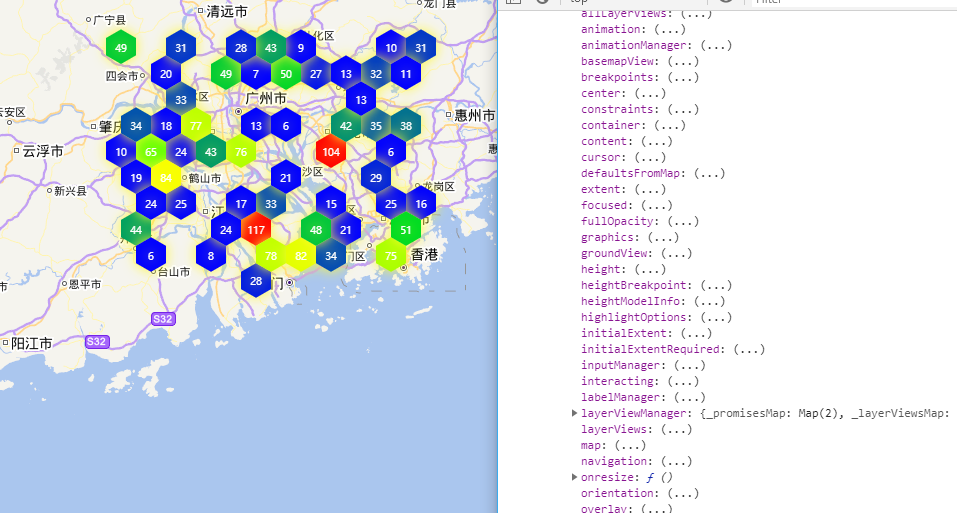因为在项目开发过程中,使用的arcgis js api版本是4.7,并不能支持客户端渲染热力图,想到arcgis js api 4.x的渲染是基于canvas,故琢磨着是否能借助类似于mapV、echart、heatmap.js等同样基于canvas的优秀可视化库来操作,本篇主要讲述拓展支持mapV图层的过程,我们可以参看mapV的相关说明,它的渲染是基于我们的屏幕坐标,而在arcgis api js 4.x中便有屏幕坐标和地理坐标的互相转换,所以这便是拓展的关键点,好了,我们来上手吧。
效果图:

安装mapV
-
npm install mapv
引用mapV对象(DataSet、图层对象)
-
import { DataSet, canvasDrawHeatmap, canvasDrawHoneycomb } from 'mapv' ;
初始化mapV图层参数
constructor(view, option) { this.view = null; this.box = null; this.mapvOption = {}; this.mapv_ctx = null; this.map_ExtentChange_Listener = null; this.map_RotateView_Listener = null; this._init(view, option); } _init(view, option) { this._setBaseMap(view); this._setMapvOption(option);//设置mapv图层参数 this.createLayer(view);//创建图层 }sv
创建mapV图层对象,并加入到地图容器
createLayer(view) { if (this.mapvOption.geoData) { if (!document.querySelector('#mapv')) { let box = this.box = document.createElement("canvas"); box.setAttribute("id", "mapv") box.setAttribute("name", "mapv") box.style.width = view.width + 'px'; box.style.height = view.height + 'px'; box.style.position = "absolute"; box.style.top = 0; box.style.left = 0; let parent = document.getElementsByClassName("esri-view-surface")[0]; parent.appendChild(box); } this.getCanvas();//获取canvas图层 this.renderLayer();//渲染图层 this.startMapEventListeners();//开启地图的监听事件 } else { document.querySelector('#mapv') && this.removeCanavs(); } } getCanvas() { let canvas = document.querySelector('#mapv'); canvas.width = document.body.offsetWidth; canvas.height = document.body.offsetHeight; this.mapv_ctx = canvas.getContext('2d'); }
渲染mapV图层到地图上
renderLayer() { let { type, visualMap } = this.mapvOption, renderLyr; let dataset = this.createDataSet();//构建图层数据及转换 switch (type) { case "heatmap"://热力图 renderLyr = canvasDrawHeatmap.draw(this.mapv_ctx, dataset, visualMap); break; case "honeycomb"://蜂窝图 renderLyr = canvasDrawHoneycomb.draw(this.mapv_ctx, dataset, visualMap); break; default: renderLyr = null; break; } }
构建图层数据及坐标转换
createDataSet() { let { geoData } = this.mapvOption; let data = this.geo2Screen(geoData); data = new DataSet(data); return data; } geo2Screen(geoData) { let { view } = this; return geoData.map((item, index) => { let temp = {}; let mapPoint = { ……
更多的详情见:GIS之家小专栏
文章尾部提供源代码下载,对本专栏感兴趣的话,可以关注一波